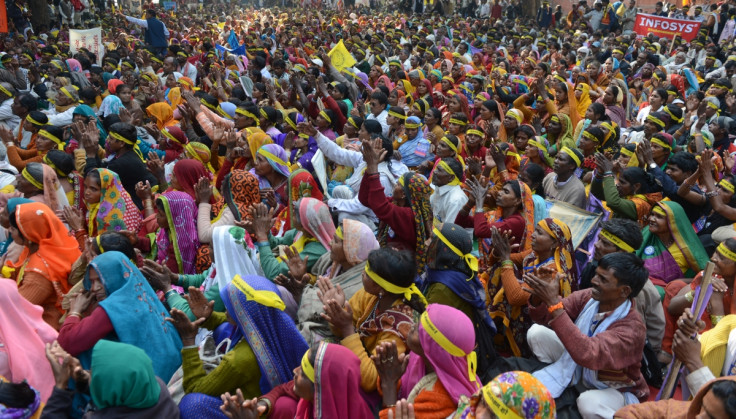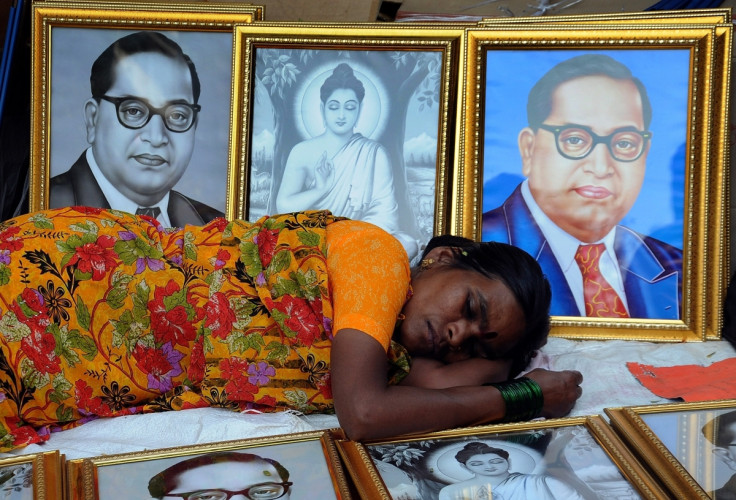India's caste system: Everything you need to know about the Hindu social hierarchy

Although India's caste system dates back centuries, the Hindu social hierarchy has been the source of a number of controversies in the country in recent months. In January, a student from the lowest social class – the 'dalit' – committed suicide, sparking an intense nationwide debate on that group's treatment. In February violent protests organised by Haryana's 'Jat' community reignited the caste debate as demonstrators demanding job quotas similar to those given to the 'dalit'.
Here IBTimes UK rounds up everything you need to know about the history and current status of the Indian caste system.
The origins of the caste system
Some Hindu theologians believe the India's caste system originated with the Hindu god of Brahma – the creator of the world and all creatures on it in Hindu mythology. It is said that the highest people of society – priests and teachers – were produced from the Brahma's mouth, warriors were produced from his arms, merchants and traders from the God's thighs, and workers and peasants from his feet.
One of the secular theories is that Aryans from central Asia invaded the country and introduced the caste system in an attempt to control India's population by giving each group a different role in society. The roles were based on factors including occupations and diet, as well as perceived qualities such as wisdom and intelligence. In the 20<sup>thcentury this theory was disproved as scholars found that there was no Aryan invasion.
The exact origins and beginnings of the caste system remain difficult to trace, however, the Manusmriti – the most important ancient legal text of Hinduism, which British rulers in India used to settle disputes among Hindus relating to inheritance, marriage and royal succession – has cited and justified the caste system in 1,000BC, stating the caste system is a set of "prescribed unequal laws for different castes based upon their status in society" and it "justifies the caste system as the basis of order and regularity of society".
The breakdown of the caste system social groups
The Manusmriti recognises four different classes of people within the caste system: the Brahman, Khatriya, Vaishya, Shudra and Dalit.
- Brahman – priests and teachers
- Kshatriya – warriors and rulers
- Vaishya – farmers, traders and merchants
- Shudra – labourers
- Dalit (also known as 'Untouchables') – street sweepers, cleaners
Traditionally, rural communities based every aspect of life on the caste system. The upper caste members lived separately from the lower caste members and even water wells would not be shared with different caste groups. Marriage outside one's caste was forbidden and, in general, the system brought many privileges for the upper castes, while the lower castes suffered repression and discrimination.
Hindus are born into their caste and without the opportunity to marry into a different social group, people are confined to their caste group for life. This meant that there was no scope for aspiring to climb the social hierarchy ladder and those in the lower castes remained where there were, stalling economic progress. Dalits faced the worst discrimination, with a United Nations report in 2005 indicating that there were more than 31,000 violent acts committed against the 'Untouchables' in a single year.

Demolition of the caste system
Following the end of British rule in India, the Indian constitution banned discrimination on the basis of caste. In 1950, authorities also announced quotas in government jobs and educational institutions for those lowest in the caste hierarchy. The government divided the lower castes into 'Scheduled Castes' and 'Scheduled Tribes'. The slightly higher-ranking castes were classified as 'Other Backward Classes' (OBC) and were awarded government quotas in 1989.
The person who authored the Indian Constitution – BR Ambedkar – was a Dalit himself and the occasion marked a significant moment for the country. Ambedkar abandoned his Hindu faith and converted to Buddhism in protest over the way that Dalits were being treated. Mahatma Gandhi also campaigned heavily for the abolition of the caste system. It was Gandhi who named renamed the 'Untouchables', 'Harijan' – the people of God.
Today, particularly in urban areas, the influence of the Hindu caste system has greatly declined. Intercaste marriages have become more common, however, family names are often a strong indication of what caste a person belongs to and continues to create a strong sense of identity.
Recent caste-related controversies
- Dalit student from 'untouchable' caste commits suicide
In January 2016 a Dalit researcher at the University of Hyderabad committed suicide, sparking a debate on the treatment of the lowest caste members. Rohit Vemula and four of his Dalit friends were reportedly suspended by the university administration days earlier, being told that they could attend classes but were not allowed to enter the hostel or common areas. Being unable to afford private housing, the Dalit group set up camp in front of the university and began a hunger strike in protest against their "social boycott".
- Haryana Jat reservation protest
In recent years, a number of communities have been demanding the right to be recognised as OBCs. The most recent was the Jat community protests in Haryana in February 2016. At least 18 people were killed after the protests turned violent, while protesters cut off a key water supply to Delhi, leaving much of the capital without water for days. The issue caused controversy among the general public as the Jat community is regarded as a prosperous and politically dominant community. However, Jat leaders insisted that they should be granted government quotas as they claim that large numbers of their communities are poor.
© Copyright IBTimes 2025. All rights reserved.






















